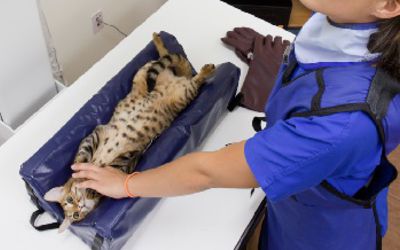
Veterinary radiography has evolved significantly over the years. Modern devices, paired with innovative techniques, ensures that our furry companions receive the superior care possible. One crucial development in this area is the use of vet x-ray positioning aids. This guide probes deep into the universe of x-ray positioning aids, giving you a thorough overview.
Understanding Vet X-ray Positioning Aids
Before delving into the details, let's first get the fundamental concept. In essence, x-ray positioning aids support veterinary professionals obtain the most exact images while guaranteeing least discomfort for the animal. They play a crucial role in holding pets in the proper position, lessening movement, and guaranteeing steady, high-quality results.
Why are X-ray Positioning Aids Crucial in Veterinary Practice?
Safety for Both Animal and Technician: Decreasing animal movement is crucial during x-ray processes. This not only makes sure clear images but also minimises the risk of radiation exposure for both the animal and the technician.
Consistent Image Quality: Steadiness is key when it comes to x-rays. Vet x-ray positioning aids help in achieving that by making sure animals are held in the right posture for clear images.
Reduction in Retakes: If a pet stirs during the x-ray procedure, the chances are high that the images might surface blurry. Positioning aids greatly reduce such occurrences, leading to fewer retakes.
Popular Types of Vet X-ray Positioning Aids
Foam Positioners: These featherweight and durable positioners are perfect for supporting the animal's body parts during radiography. They come in various shapes and sizes made to fit different animals and body parts.
Sandbags: They're excellent for securing and positioning. Their weight helps stop movement during the x-ray operation.
Tape and Straps: These can be used to bind limbs in place. They're gentle on the skin and can be altered based on the pet's comfort.
Immobilisation Devices: For pets that are particularly agitated, immobilisation devices can give a safe way to keep them still during the x-ray process without creating any discomfort.
Selecting the Right X-ray Positioning Aids for Your Veterinary Clinic
With the range of aids on hand, selecting the right one might feel daunting. However, consider the following factors:
Type of Animals Treated: A clinic mainly handling with small pets might have different requirements than one dealing with larger animals.
Frequency of Use: Resilient positioning aids are a requirement for busy clinics.
Budget: While it's vital not to sacrifice on quality, vet clinics also need to ascertain they're making cost-effective decisions.
Tips for Using Vet X-ray Positioning Aids Effectively
Training is Crucial: Guarantee that all your staff are adequately trained in using the aids. This will ensure the safety and comfort of the animals while getting the best possible x-ray images.
Regular Maintenance: Like all machinery, vet x-ray positioning aids also deteriorate with time. Regularly check for wear and tear and substitute them when needed.
Prioritise Comfort: While securing the flawless image is vital, it's equally vital to make sure the animal's comfort. Always verify that any restraints or positioners used are not causing any distress to the animal.
Vet x-ray positioning aids have transformed the field of veterinary radiography. They have not only guaranteed the generation of clear, high-quality images but have also had a major role in enhancing the safety and comfort of the pets undergoing the process. As veterinary professionals, it's our duty to make sure we're armed with the best tools and knowledge to render our furry customers the best care imaginable.
If you're looking to upgrade your veterinary clinic with the latest x-ray positioning aids or need more information about them, visit xray4vets. Plunge into a domain of advanced veterinary gear and elevate the care you render to your beloved animal patients.